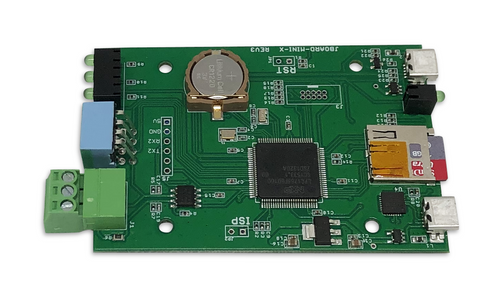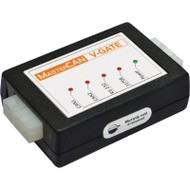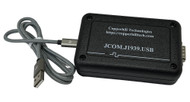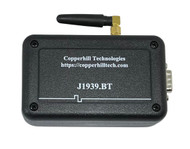SAE J1939 Gateway Module With USB Port, RTC, MicroSD Memory Card
Product Description
Alternative Product
This device's functionality is 100% compatible. The only difference is an additional power supply.
General Features
- Fully SAE J1939 compliant hardware with on-chip SAE J1939 protocol, including Transport Protocol (TP)
- Free-of-charge Windows analyzer software
- Monitor, record, and analyze SAE J1939 data traffic, including timestamping
- Simulate SAE J1939 data traffic
- Respond to message requests
- Define message filters
- Automatic node address negotiation
- Fully programmable per USB port
- Virtually OS independent
- Programming sample for Windows, Linux, and embedded systems
- Easy firmware update for customized functionality or added features
- Future extension include:
- Onboard data recording per micro SD card
- Replay of recorded data
- SAE J1939 data traffic simulation without PC connection
Hardware Features
The JCOM.J939.USB-X SAE J1939 Processor board is an extended version of our popular JCOM.J9139.USB-B SAE J1939 ECU Simulator Board With USB Port. The most significant difference is that the -X version supports a USB transfer rate of up to 480 Mbps, allowing higher data throughput. Also, the onboard real-time clock supports the time-stamping of the SAE J1939 data frames (PGN).
Furthermore, the board comes with a MicroSD memory card slot, which opens the door to future applications such as a CAN Bus / SAE J1939 data logger.
The improved features are:
- Upgraded ARM Cortex-M3 processor with double Flash & RAM
- Supports Hi-Speed USB 2.0 transfer rate at up to 480 Mbps
- Additional UART-USB for onsite firmware programming
- Onboard Real-Time Clock (RTC) for CAN Bus message timestamp support
- MicroSD Memory Card support
- 4-position DIP switch (one for termination resistor, three for functionality settings)
- Additional serial (UART) port for GPS sensor or SAE J1708 board
Product Description
The jCOM.J1939.USB processor board is a high-performance, low-latency vehicle network adapter for SAE J1939 applications. It allows any host device with a USB COM port to monitor SAE J1939 data traffic and communicate with the SAE J1939 vehicle network.
The board supports the full SAE J1939 protocol according to J1939/81 Network Management (Address Claiming) and J1939/21 Transport Protocol (TP). It is also supported by an extensive programming interface for Windows and Linux/Ubuntu applications, including full C/C++/C# source code for short time-to-market developments.
The strength of the board lies in the fact that the entire SAE J1939 protocol, including all timing requirements, is stored on-chip, thus taking the burden off the central system (PC). The board uses a USB COM port to communicate with the central system, i.e., all data transfer is handled through a standard COM port access. The communication protocol between the board and the primary system is well documented and thus allows a porting to any computer system with a USB connection. Working source code libraries exist for Windows (C# under Visual Studio 2102/2013), Linux and its derivatives (C++ using Code::Blocks), and Raspberry Pi (C using the standard gcc compiler).
With all its features, the jCOM.J1939.USB allows the simulation of an SAE J1939 ECU (Electronic Control Unit) using embedded solutions such as the Raspberry Pi, BeagleBone, Arduino, Teensy, and others but also PCs running Windows or Linux (incl. Ubuntu, Fedora).
Firmware Versions
We provide free-of-charge firmware updates. Downloading and programming a new firmware version is quick and easy.
SAE J1939 Starter Kit
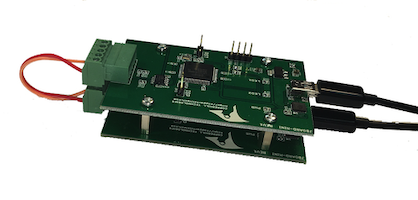 It may sound obvious to the experienced J1939 user, but you will need a second J1939 node to establish a network.
It may sound obvious to the experienced J1939 user, but you will need a second J1939 node to establish a network.
If you are a beginner to the J1939 technology and/or you do not have a second J1939 node available, please consider our SAE J1939 Starter Kit and Network Simulator. The Starter Kit is a helpful tool for creating and analyzing J1939 data traffic.
Testing A Device With "Silent Mode" Or Automatic CAN Baudrate Detection?
If you need to communicate with an SAE J1939 node that starts up in "Silent Mode" or supports automatic baudrate detection, please be aware that our USB device will not be able to recognize it. You will be better off using our SAE J1939 Starter Kit as described above,
For more information, see How CAN Bus Automatic Baudrate Detection Works And What To Consider When Connecting To A Network.
Board Components
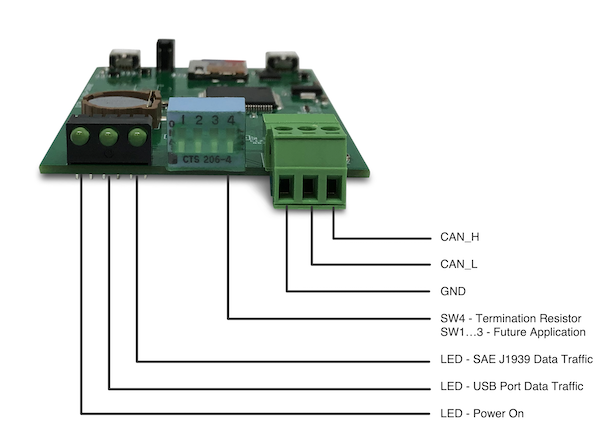
Notes:
- SW1 = ON - Disables the USB Communication Port and uses the USB Programming Port instead. This setting applies after a Reset of the gateway. It establishes hardware compatibility with the JCOM.J1939.USB-B gateway (USB-to-UART converter at 115,200 baud). This feature applies to firmware version 2.01.00 and higher.
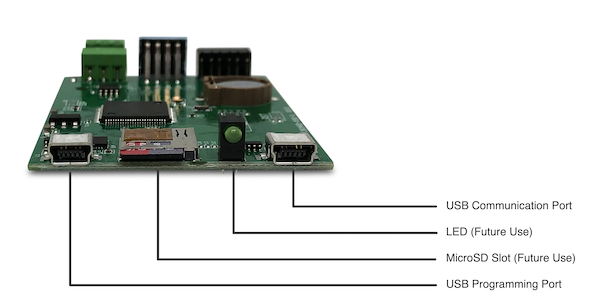
Notes:
- The driver for the USB Communication Port is installed automatically by the Windows operating system.
- The USB Programming Port is used for future firmware updates.
- The MicroSD card slot will support future applications, such as a CAN Bus or SAE J1939 Data Logger. All future updates will be available free-of-charge.
- The LED will indicate SD card access.
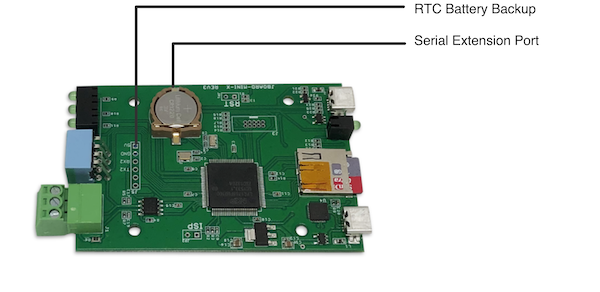
Notes:
- The RTC battery size is Lithium CR1220 (battery not included). The battery is not needed when operating the board with our JCOM1939 Monitor Software, since the software synchronizes the time between the PC and the onboard RTC. The battery will be necessary when operating the board independently from PC communication (future feature).
- The serial extension board allows adding a GPS sensor or an SAE J1708 board (future applications).
Free-Of-Charge Windows Software
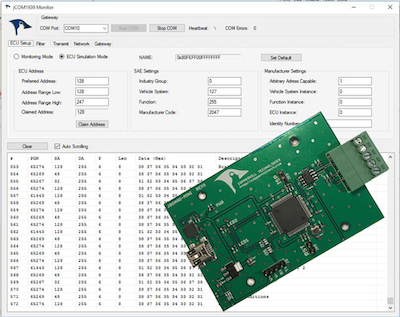 The communication protocol between the gateway and the host system (PC, Embedded System, Android System, etc.) is well documented, and we provide C/C# source code to read and write CAN data frames (for more information, see our wiki page).
The communication protocol between the gateway and the host system (PC, Embedded System, Android System, etc.) is well documented, and we provide C/C# source code to read and write CAN data frames (for more information, see our wiki page).
In addition, the gateway is supported by our free-of-charge jCOM1939 MonitorPro-X, an SAE J1939 Monitoring, Analyzer and ECU Simulation software under Windows.
The jCOM1939 Monitor Software is the perfect tool to monitor, analyze, and simulate SAE J1939 data traffic. The system combines our jCOM.J1939.USB that functions as an SAE J1939 to USB (or UART) gateway. A comprehensive and easy-to-use, easy-to-understand Windows software displays not only SAE J1939 data traffic; it also allows to scan the network, simulate an ECU (incl. full node address negotiation features), and respond to data request messages.
jCOM.J1939.USB General Features:
- Full SAE J1939 Protocol on chip
- Virtually OS independent
- Easily adaptable; just access the COM port
- Works with PCs, Raspberry Pi, BeagleBone, Teensy, Arduino
- Protocol is well documented
- C source code available
- Windows tool: jCOM1939 Monitor
- Power applied through USB port
- Power consumption 0.486 W - 0.097A @ 5VDC
(Average; changes with CAN bus load) - Operating Range: -40...+85 C
- Board dimensions (W x L ): 52 x 78 ; 2.05" x 3.07"
Supported SAE J1939 Features Include:
- Hardware is fully SAE J1939/1x compliant
- Switchable termination resistor
- SAE J1939/21 - Data Link Layer
- SAE J1939/81 - Network Management
- Setup of Preferred Node Address
- Adjustable Node Address Negotiation Range
- Message Filters
- Full Network Communication incl. Transport Protocol
- Design Tx Messages Incl. Transmission Rate
- Configuration of Request Responses
- Configuration of Request Messages
- Network Scanner (Creates a list of all nodes in the network)
Resources
- Communication Protocol Between the Gateway and the Host System (PDF)...
- Programming the SAE J1939 ECU Simulator Board Using Visual Studio C#
- Simulating SAE J1939 PGNs Used By Truck & Bus FMS (Fleet Management System) Standard
- SAE J1939 Address Claim Procedure - SAE J1939/81 Network Management
- SAE J1939 Monitor Software - Setting Up PGN Simulation Such As Engine Coolant Temperature
- SAE J1939 To USB Gateway Records J1939 Data Frames (PGNs) To Micro SD Card
SAE J1939 Insights
- SAE J1939 Message Format And Interpretation Of PGNs...
- SAE J1939 Utilizes CAN Bus Message Collision During Bus Arbitration...
A Comprehensible Guide to J1939
SAE J1939 has become the accepted industry standard and the vehicle network technology of choice for off-highway machines in applications such as construction, material handling, and forestry machines. J1939 is a higher-layer protocol based on Controller Area Network (CAN Bus).
It provides serial data communications between microprocessor systems (also called Electronic Control Units - ECU) in any kind of heavy duty vehicles. The messages exchanged between these units can be data such as vehicle road speed, torque control message from the transmission to the engine, oil temperature, and many more.
The information in this book is based on two documents of the SAE J1939 Standards Collection: J1939/21 - Data Link Layer J1939/81 - Network Management A Comprehensible Guide to J1939 is the first work on J1939 besides the SAE J1939 standards collection.
It provides profound information on the J1939 message format and network management combined with a high level of readability.
 Loading... Please wait...
Loading... Please wait...

